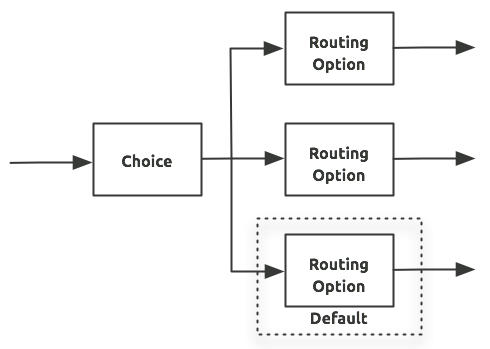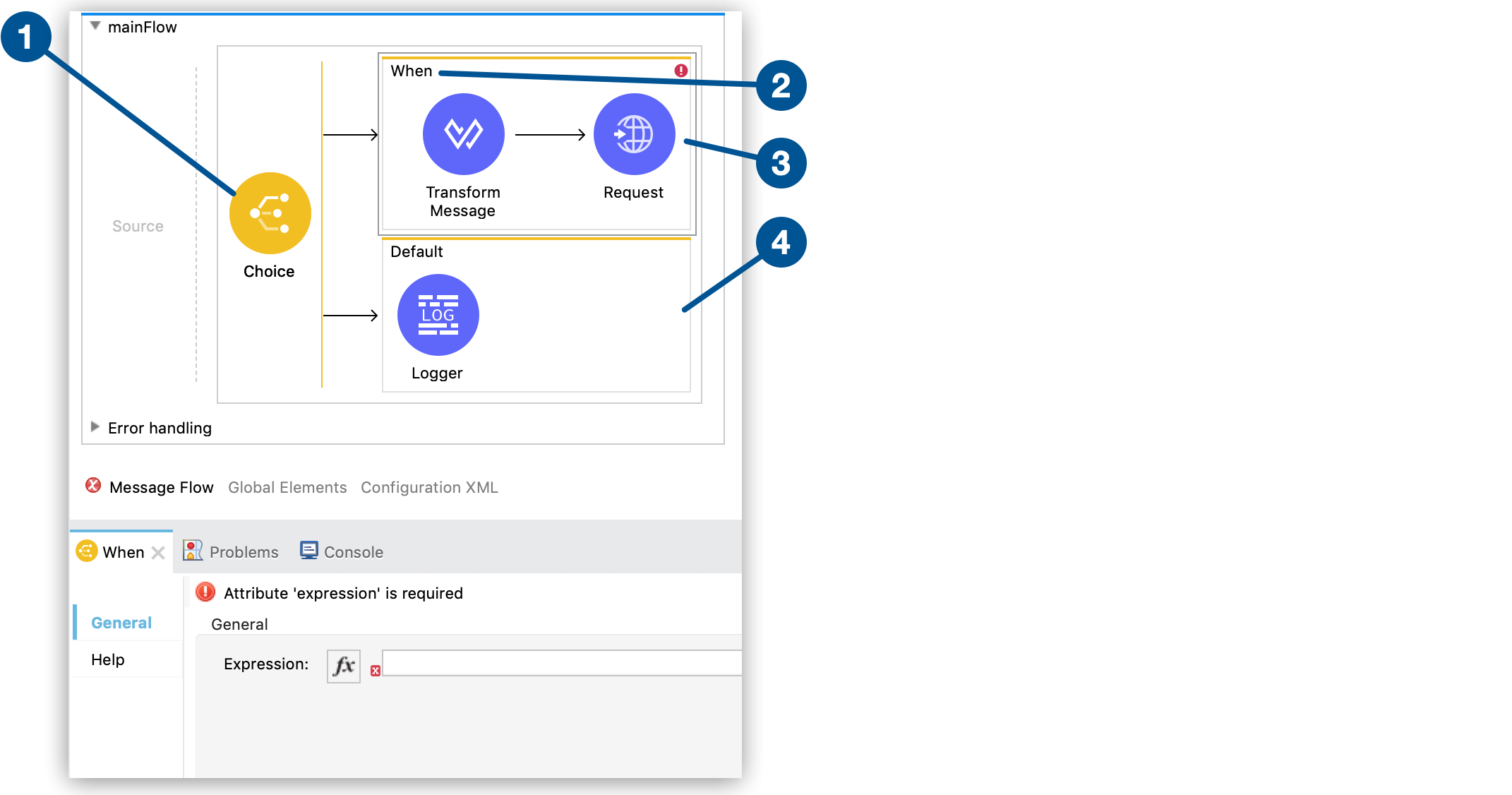
Choice Router
|
Standard Support for Mule 4.1 ended on November 2, 2020, and this version of Mule reached its End of Life on November 2, 2022, when Extended Support ended. Deployments of new applications to CloudHub that use this version of Mule are no longer allowed. Only in-place updates to applications are permitted. MuleSoft recommends that you upgrade to the latest version of Mule 4 that is in Standard Support so that your applications run with the latest fixes and security enhancements. |
The Choice router dynamically routes messages through a flow according to a set of DataWeave expressions that evaluate message content. Each expression is associated with a different routing option. The effect is to add conditional processing to a flow, similar to an if/then/else code block in most programming languages.
Only one of the routes in the Choice router executes, meaning that the first expression that evaluates to true triggers that route’s execution and the others are not checked. If none of the expressions are true, then the default route executes.

Configuration
To configure the Choice router, specify one or more conditions to evaluate, and the message processors that execute when any condition evaluates to true. Additionally, configure a default route that executes when none of the defined conditions are true.
Anypoint Studio Configuration
To configure the Choice router in Studio, follow these steps:

-
Drag the Choice component to any point of the flow.
-
Click When, inside the Choice router, and configure the Expression value in the properties window to specify the condition to evaluate.
-
Drag message processors inside When to specify the processors to execute when the condition is met.
-
Drag message processors inside Default to specify the processors to execute when none of the defined conditions are met.
XML Configuration
Following is the basic XML structure for a Choice router:
<choice doc:name="Choice">
<when expression=${expressionToEvaluate}> (1)
<!-- Message processors --> (2)
</when>
<otherwise>
<!-- Message processors--> (3)
</otherwise>
</choice>| 1 | The expression attribute has the condition to evaluate. |
| 2 | Add any number of message processors to execute if expression evaluates to true. |
| 3 | Add any number of message processors to execute if none of the conditions evaluates to true. |
Adding Routes to the Choice Router
By default, the Choice router has one route option that executes when the configured DataWeave expression evaluates to true, and a default route that executes when none of the expressions in the existing routes are true. Add more routes when you need to evaluate more than one condition and then execute different operations depending on which condition is met.
Add Routes by Dragging Components in Studio
From Mule Palette in Anypoint Studio, click any component and drag it into the Choice router, where you see a vertical black line:

Add Routes by Editing the XML
You can also add additional route options to a Choice router by modifying the XML configuration file:
-
In Studio, right-click the Choice router and select Go to XML….
-
Inside the
<choice>element, add a<when>element:<!--Content based routing example flow --> <flow name="content-based-routingFlow"> <http:listener config-ref="HTTP_Listener_config" path="/" doc:name="Listener"/> <set-variable variableName="language" value="#[attributes.queryParams.language]" doc:name="Set Variable" /> <!-- Choice router block--> <choice doc:name="Choice" > <when expression="#[vars.language == 'Spanish']" > <set-payload value="Hola!" doc:name="Reply in Spanish" /> </when> <when expression="#[vars.language == 'French']" > <set-payload value="Bonjour!" doc:name="Reply in French" /> </when> <!-- This is the new route option added in this step --> <when> </when> <otherwise> <flow-ref name="reply-in-default-languageSub_Flow" doc:name="reply-in-default-languageSub_Flow" /> </otherwise> </choice> <logger level="INFO" doc:name="Log the reply" message='#["The reply $(payload) means hello in $(vars.language)" ]'/> </flow>
After adding a new <when> element, the new route option shows in the Message Flow view:

Example Project
You can use Anypoint Studio to download the example project Content-Based Routing from Anypoint Exchange. This project presents a working example of a flow that uses the Choice router.

To download and open this example project:
-
Click the Exchange icon (
 ) in Anypoint Studio.
) in Anypoint Studio. -
In the left panel, click All assets.
-
In the window that opens, log in to Anypoint Exchange and search for the example project Content-Based Routing.
-
Click the Open icon (
 ).
).
Behavior of the Example Project
When you run the project as a Mule application, the application performs the following actions:
-
Listens for messages.
-
Passes messages to a Set Variable component that sets the variable
languageto the language that is passed in the message by the parameterlanguage. -
Uses a Choice router to find out whether each message contains a
languageattribute. The presence and value of this attribute determine how the Choice router routes the message:-
If the value is
French, the router routes the message to a Set Payload component that is named Reply in French. This latter component returns the messageBonjour!to the requester. -
If the value is
Spanish, the router routes the message to a Set Payload component that is named Reply in Spanish. This latter component returns the messageHola!to the requester. -
If the message contains no
languageattribute, the router routes the message to the default path, which is a subflow that:
-
-
Logs the message "No language specified. Using English as a default." to the console
-
Sets the value of
languagetoEnglish. -
Returns the message
Hello!.
The example project demonstrates that, when you are planning to route messages in a flow by using a Choice router, there are four aspects to planning that you need to consider:
-
The content that the Choice router evaluates to determine how it routes messages
-
The number of routes
-
The default routing option
-
The processing that the flow performs for each routing option
Example XML
Following is the XML code for the Choice router example:
<mule xmlns:http="http://www.mulesoft.org/schema/mule/http" xmlns="http://www.mulesoft.org/schema/mule/core"
xmlns:doc="http://www.mulesoft.org/schema/mule/documentation"
xmlns:spring="http://www.springframework.org/schema/beans"
xmlns:xsi="http://www.w3.org/2001/XMLSchema-instance" xsi:schemaLocation="http://www.springframework.org/schema/beans http://www.springframework.org/schema/beans/spring-beans-current.xsd
http://www.mulesoft.org/schema/mule/core http://www.mulesoft.org/schema/mule/core/current/mule.xsd
http://www.mulesoft.org/schema/mule/http http://www.mulesoft.org/schema/mule/http/current/mule-http.xsd">
<http:listener-config name="HTTP_Listener_config" doc:name="HTTP Listener config" >
<http:listener-connection host="0.0.0.0" port="8081" />
</http:listener-config>
<flow name="content-based-routingFlow" >
<http:listener config-ref="HTTP_Listener_config" path="/" doc:name="Listener" />
<set-variable variableName="language" value="#[attributes.queryParams.language]" doc:name="Set Variable" />
<!-- START OF CHOICE BLOCK-->
<choice doc:name="Choice" >
<when expression="#[vars.language == 'Spanish']" >
<set-payload value="Hola!" doc:name="Reply in Spanish" />
</when>
<when expression="#[vars.language == 'French']" >
<set-payload value="Bonjour!" doc:name="Reply in French" />
</when>
<otherwise>
<flow-ref name="reply-in-default-languageSub_Flow" doc:name="reply-in-default-languageSub_Flow" />
</otherwise>
</choice>
<!-- END OF CHOICE BLOCK-->
<logger level="INFO" doc:name="Log the reply" message='#["The reply $(payload) means hello in $(vars.language)" ]'/>
</flow>
<sub-flow name="reply-in-default-languageSub_Flow" >
<logger level="INFO" doc:name="Logger" message="No language specified. Using English as a default. "/>
<set-variable variableName="language" value="English" doc:name="Set Language to English" />
<set-payload value="Hello!" doc:name="Reply in English" />
</sub-flow>
</mule>Choice Router XML Reference
A Choice flow control component contains these elements:
-
A single root element
<choice> -
A
<when>child element for each routing option, each with an expression to match -
Optionally, an
<otherwise>child element of Choice that handles all cases where none of the expressions on the<when>elements evaluate totrue -
Components that are conditionally executed under each of the choices are defined as child elements of the
whenandotherwiseelements



